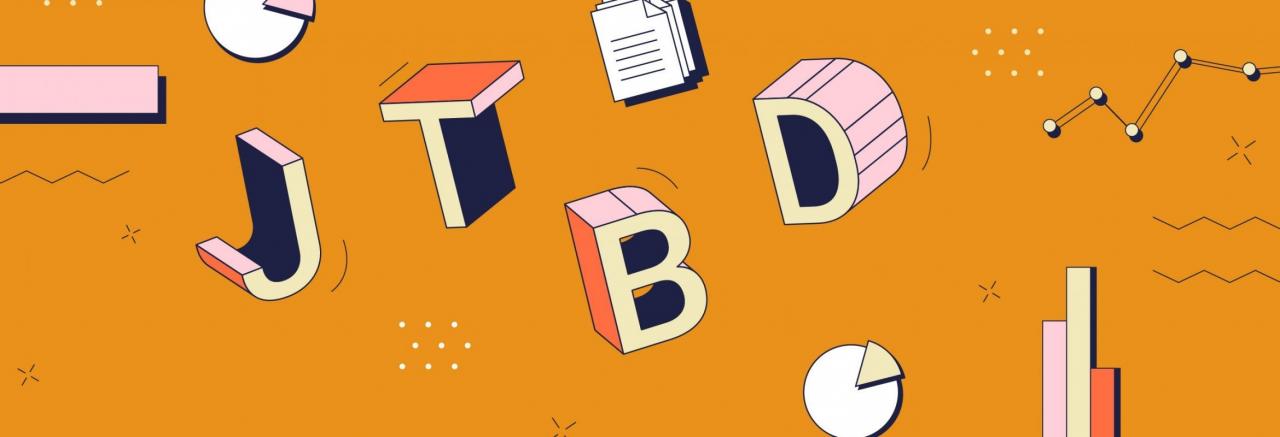Use JTBD to develop products that your customers really want
The customer, the unknown being
“Our new software sells badly”, “ The functions of our app are not being used ”or“ We need a groundbreaking feature quickly, otherwise we will lose touch with the competition”: You may be familiar with statements like this. They are done in similar ways in different companies countless times every day.

This is usually followed by questions such as: Why is our product unsuccessful? Why doesn’t it find customers? Why don’t users use it the way we thought? What do we have to change to become more successful?
In summary, the big question is: What do our customers really want? One method to find the right answer is Jobs To Be Done.
What about jobs? To be done on yourself?
Clayton M. Christensen is known as the “father of disruption”. The American economist, management consultant, professor, and successful author coined the term “disruption” in 1997 in his book “The Innovator’s Dilemma”. Christensen also invented the theory of Jobs To Be Done, which he explained in 2016 in his book “Competing against luck”.
Meanwhile, JTBD has become involved in many management Established processes, for example, Design Thinking or a Lean Startup approach. Jobs To Be Done can be carried out in any company size, as well as in different departments. The results are just as interesting for programmers as they are for marketing and sales professionals or managing directors.
The name Jobs To Be Done is based on the following assumption by Christensen: Everyone assigns a product to a job to achieve progress. The terms “commissioning”, “product”, “job” and “progress” are to be interpreted broadly.
An example: You commission your coffee machine to manufacture a product that wakes you up. The result is called coffee, but it could also be an energy drink or tea with caffeine. Maybe you don’t need a drink at all, but a lap on the treadmill or a breath of fresh morning air? The main thing is that your tiredness disappears.
That is exactly the essence of JTBD: You find out what your customers really want. Would you like to drink coffee or wake up? What progress should the job and the assignment bring?
You can transfer the questions to software products: Do users want a program with which they can enter numbers in cells to create tables and curve diagrams create? Are you looking for a solution to present the quarterly figures impressively? Or do you want to impress your boss deep down so that a raise beckons? Do you need software that works like Excel? Not necessarily.
People need solutions, the tools are just the means to an end. A well-known symbol for this is: People don’t want to buy a hammer, they want to hang up a picture.
Jobs To Be Done and the development of innovations
Innovations are important. Companies are under increasing pressure due to globalization, digitization, and automation. Products that have worked for decades and have been successful are being squeezed by new developments. Sometimes the upheavals are so strong that one speaks of disruption – the breaking up and shedding of well-known structures.
Such disruption is happening in the automotive industry, for example. Gottlieb Daimler and Carl Benz invented the car in 1886. And, to put it simply, it still works as it did back then. Comfortable seats, efficient engines, safety systems, navigation devices – these have all been evolutionary developments over the past 134 years. They made sense and worked.
Now a revolution is imminent, which is happening on different levels: people use car-sharing, the dream of autonomous cars, and air taxis. They use e-bikes and e-scooters to replace cars. Or they do without their “Heilig’s Blechle” because, thanks to e-commerce and video conferencing, they leave the house less often.
There are numerous reasons behind these changes. These induce drivers to change their behavior. The needs behind it can be of an emotional, social, and/or functional nature. You can find out exactly what these are and how the behavior change came about with the JTBD method.
JTBD as a tool for backward-looking market research
What do our customers want? To answer this question, companies like to commission expensive market research institutes to carry out qualitative and quantitative studies. They ask the test subjects what they want. Or what they think of a product. The problem with this is that what people think, what they say, and how they act are usually three different things. We know that cars and business flights are harmful to the environment and we want more environmental protection. But so far there are more company cars than accounts for video conferencing tools.
Why is that so? What motivates people to behave and make a decision? Especially about the decisions that involve a change in behavior or a purchase? This is where JTBD starts with its approach to shed light on the past of the respondents.
With a special interview technique, you can find out what the jobs and the triggers are. As the interviewer, you concentrate on the living conditions, special situations, and emotions of the customers. The goal is to find out the functional, emotional, and/or social needs.
Example: The job of a milkshake
During his research, Clayton M. Christensen discovered that products usually have more competitors than the manufacturers know themselves. He describes the best-known result in his “Milkshake Dilemma”. This sheds light on the secret of the success of sweet milk drinks.
The result is astonishing: many commuters bought a milkshake in the morning before work. Because these can easily be consumed in the car without crumbling or sticking. By “sucking” they provide variety in traffic jams and they fill you up. This means that a milkshake not only competes with other milk products, but also with to-go offers such as sandwiches, muesli bars, and donuts. That was just a realization from Christensen. Because the consumers who bought a milkshake in the afternoon have completely different jobs that the drink should do.
If you use the JTBD method, you will quickly notice how diverse the needs of your customers are. And that your product can be swapped for another quickly if the customers want it. For example, Netflix’s competitors are Amazon Prime Video, Disney +, and Apple TV, as well as game consoles, eBooks, and beds. All of these products ensure that you can relax – that is the job you are entrusted with.
What does this mean for (agile) software development?
Let’s come back to one of the questions asked at the beginning: Why is your product unsuccessful? There can be many answers to this. One could be: It does not meet the needs of your (potential) customers at all or only insufficiently. Or not to the extent that it used to be.
If your product has been on the market for a long time, you have surely developed it over the years. For example, by adding new features. But this evolutionary progress made your software complicated to use. It suffers from so-called “features”, the overload with features that distract from the core task. The customers, therefore, turn away and use a different solution – in the form of competing for software, with a workaround or a completely different product.

What does the user want? This question also arises when you develop new software or other digital product. An agile Scrum approach and the development of an MVP can help you develop a customer-centric product. In the gradual improvement of the product vision, JTBD proves to be a useful tool. One that you use to make and validate new assumptions.
Do some field research:
- Ask a selected group of users how they came to purchase or use your product.
- So that you get the survey If it is easier, you can use special JTBD interview cards. And re-drill by, for example, the 5-Why-Method Use.
- Hold Record the test persons’ statements with a dictation machine (or a corresponding smartphone app).
- values The interviews. Analyze the so-called pains (pain points) and gains (positive, reinforcing factors) that influenced a decision.
- You should structure the pains and gains, a value proposition canvas or the Wheel of Progress specially developed for JTBD
- Create job stories based on are based on this principle: Situation> Motivation> Result.
For example: “If the end of the month is approaching, I would like to be praised by my manager for the chic presentation of the sales figures, so that I can continue my career.”
Conclusion
Getting an understanding of customers is a complicated process. One that is often based on assumptions and misinterpreted data. This makes improving a product or developing innovations a game of chance.
Reduce the chance factor by using Jobs To Be Done. Find out why people really choose a product. Usually, there are many considerations, feelings, and triggers behind it. You can use the knowledge to respond more specifically to customer requirements. And with it, you create products that your customers like to use.

